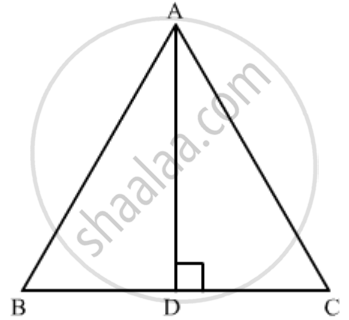Advertisements
Advertisements
Question
If ∆ABC is an equilateral triangle such that AD ⊥ BC, then AD2 =
Options
- \[\frac{3}{2} {DC}^2\]
2 DC2
3 CD2
4 DC2
Solution
Given: In an equilateral ΔABC, `AD ⊥ BC`.
Since `AD ⊥ BC`., BD = CD = \[\frac{BC}{2}\]
Applying Pythagoras theorem,

In ΔADC
`AC^2+AD^2+DC^2`
`BC^2=AD^2+DC^2`(Since AC=BC)
`(2DC)^2=AD^2+DC^2`(Since BC=2DC)
`4DC^2=AD^2+DC^2`
`3DC^2=AD^2`
`3DC^2=AD^2`
We got the result as `c`
APPEARS IN
RELATED QUESTIONS
In each of the following figures, you find who triangles. Indicate whether the triangles are similar. Give reasons in support of your answer.

Corresponding sides of two triangles are in the ratio 2 : 3. If the area of the smaller triangle is 48 cm2, determine the area of the larger triangle.
In ∆ABC, AD is a median. Prove that AB2 + AC2 = 2AD2 + 2DC2.
If ∆ABC and ∆DEF are similar triangles such that AB = 3 cm, BC = 2 cm, CA = 2.5 cm and EF = 4 cm, write the perimeter of ∆DEF.
In the given figure, ∆AHK is similar to ∆ABC. If AK = 10 cm, BC = 3.5 cm and HK = 7 cm, find AC.

In a ∆ABC, AD is the bisector of ∠BAC. If AB = 6 cm, AC = 5 cm and BD = 3 cm, then DC =
∆ABC ∼ ∆PQR such that ar(∆ABC) = 4 ar(∆PQR). If BC = 12 cm, then QR =
In the given figure, if PB || CF and DP || EF, then \[\frac{AD}{DE} =\]
∆ABC is such that AB = 3 cm, BC = 2 cm and CA = 2.5 cm. If ∆DEF ∼ ∆ABC and EF = 4 cm, then perimeter of ∆DEF is
In ∆ABC, a line XY parallel to BC cuts AB at X and AC at Y. If BY bisects ∠XYC, then
